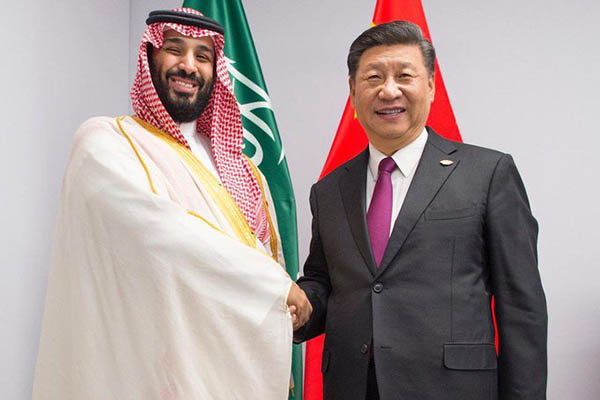
Saudi Arabia Crown Prince Mohammad bin Salman with Chinese President Xi Jinping. Photo courtesy Saudi Arabia Foreign Ministry
Chinese President Xi Jinping last week concluded a three-day visit to Saudi Arabia that may well prop up Pakistan as a major player in the new power-game emerging between Beijing and Washington over the latter’s policy of confronting China in the Indo-Pacific region.
Xi’s visit to Saudi Arabia followed a visit of American President Joe Biden, which was not met with much enthusiasm by Gulf Arabs. Describing Xi’s visit as “an epoch-making milestone in the history of China-Arab relations,” a Chinese spokesman said the summit was “the largest and highest-level diplomatic event between China and the Arab world” since the founding of the People’s Republic of China.
China is no stranger to the Gulf, having held regular ministerial meetings with members of the Arab League under the China-Arab Cooperation Forum, the last occurring in Beijing in 2018. Saudi Arabia is also China’s top oil supplier, making up 18 percent of its total crude oil purchases, with imports worth $55.5 billion. But China’s decision to foster better ties, most likely through the China-Pakistan Economic Corridor (CPEC), may politically change the region forever. “China’s major motivation for wanting to build a port in Gwadar is not commercial. The port is crucial due to China’s internal and foreign security policy. Furthermore, the port is situated at the mouth of the Strait of Hormuz, on the Arabian Sea’s shore, and close to the Persian Gulf. It is also a crucial location since it is the world’s third biggest port,” said one commentator on CPEC. Are we then standing on the cusp of a new regional change that affects both the Gulf and South Asia?
Given China’s desire to improve its access to the Indian Ocean, Gwadar Port is becoming increasingly important for Beijing. Due to its linkages to various vital maritime routes via which the great majority of oil shipments of the globe travel, “the expansion of this port appears to be particularly essential for the storage of oil from the Middle East.” Barely 400km from the Strait of Hormuz, which transports nearly 40 percent of China’s imported oil, Gwadar is Pakistan’s most important opening to the Gulf and forces Islamabad to focus more seriously on resolving the unrest brewing among the region’s local population.
But while China is serious; Pakistan may not be. In 2015, Beijing changed a $230 million loan to Pakistan for the construction of the Gwadar airport into a grant, demonstrating the importance of the project. China has also converted a $140 million loan for a highway project connecting Gwadar to Pakistan’s coastline route into an interest-free loan.
The Gwadar Port can accommodate three ships with a combined weight of 50,000 tons and a length of 200 meters. The port’s anticipated annual capacity is 137,000 container cargoes and 868,000 general cargoes. Islamabad has indicated that 91 percent of the port’s income would go to the China Overseas Ports Holding Company, which will also run its commercial activities. Beyond the Gulf, CPEC could also become China’s best trade route to India compared to its current dilatory Southeast Asian sea-route.
